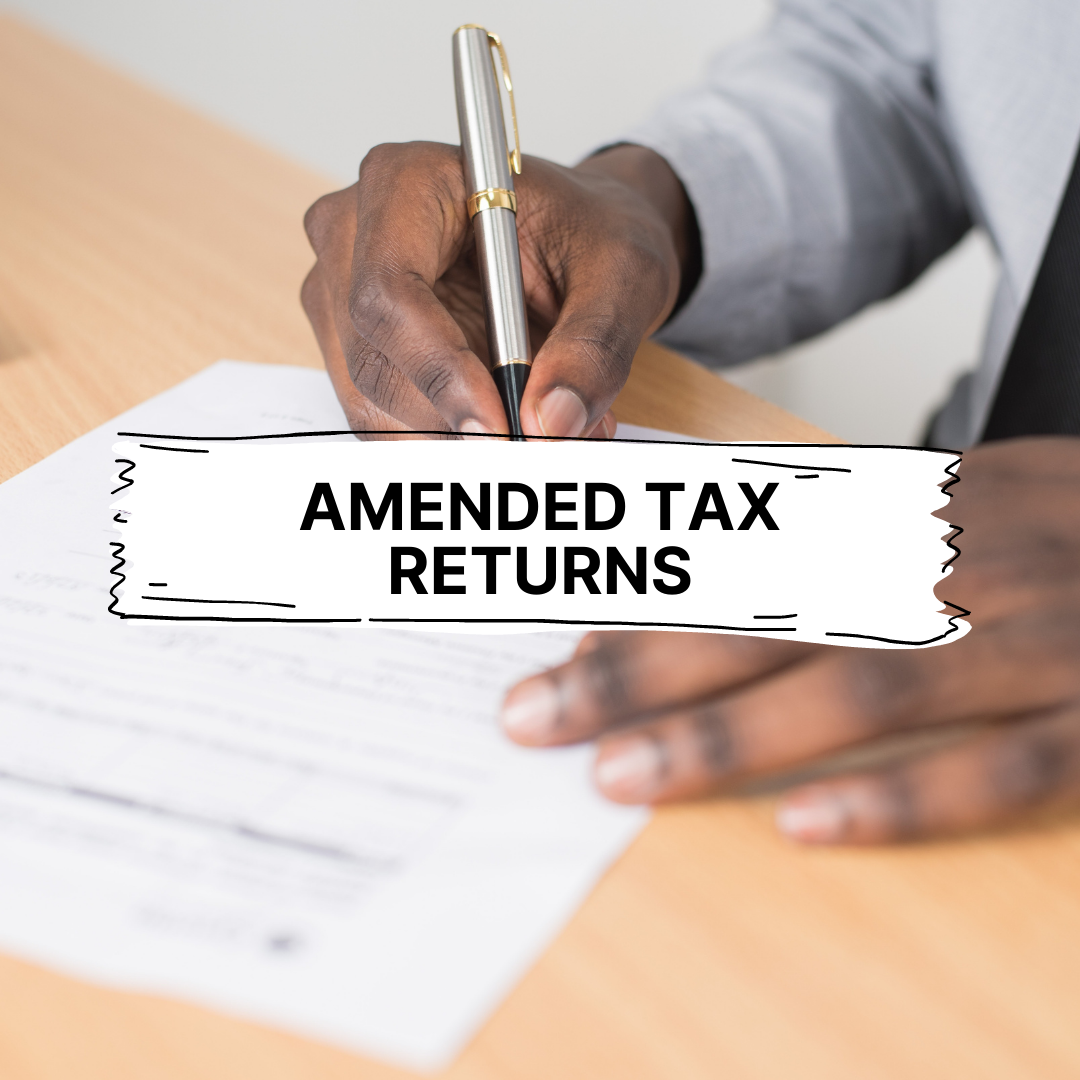Amended tax returns are submitted by filing a form to correct the final tax return for the previous year.
Before we jump into the good bits, here's what we have in store for you:
- What are Amended Tax Returns?
- Who Should File Amended Tax Returns?
- When to File Amended Tax Returns?
- When NOT to File Amended Tax Returns
- How to File Amended Tax Returns
- Some facts about filing File Amended Tax Returns
- What to include in your Amended Tax Returns?
- How can you track the status of your Amended Tax Returns?
- The due date for filing Form 1040X
- What should you consider when you file the amended tax returns 1040X form
- Advantages of filing amended tax returns
- Disadvantages of filing amended tax returns
What are Amended Tax Returns?
Amended tax returns are a lucrative way to modify the declaration of taxes in the previous year, fix errors, and allow you to claim a more favorable tax status, such as refunds. For example, you can choose to file amended tax returns if your income or tax credit is incorrectly reported.
However, there is no need for you to report any kind of mathematical error as the IRS automatically corrects these errors while processing the tax return.
Who Should File Amended Tax Returns?
All taxpayers need to file their taxes for the previous tax year. Taxpayers may have made a mistake in filling out their tax returns, or the situation may have changed after filing or mailing a government-approved tax return. In this case, the Internal Revenue Service (IRS) has provided these individuals with a way to renew their taxes by posting a modified return form, Form 1040X, on the IRS website.
For managing your accounting, try cloud software's such as Deskera, which can help you automate your financial reports and manage your tax fillings better. You can check out the video below:
The amended tax returns can be filed even after the tax return period for the specific tax period has expired. You don't have to use the form to fix all the errors.
For example, when you file your first tax return for processing, the IRS recognizes and corrects mathematical errors. In this case, the unpaid refund will be adjusted and additional tax obligations will be charged to the taxpayer. In case of any missing information that is required by the IRS, it will be intimated to the taxpayer through a letter, to send the details to one of their offices.
When to File Amended Tax Returns?
Taxpayers are required to submit amended tax returns if:
- The taxpayer's filing status for the tax year has changed or was entered incorrectly. For example, if you were registered as single but got married during the tax year, you will need to file the amended tax returns with the appropriate status – MFS - married filing separately or MFJ - married filing jointly
- You would need to submit amended tax returns if the number of dependents claimed is inaccurate. If the taxpayer needs to remove the previously claimed dependent or claim additional dependents, he would need to fill the amended tax returns. For example, a couple may not have included a baby born in November in their tax return for the previous year before the tax was filed in April. This baby was born in the previous taxation year and should be included as a dependent in the previous year's tax return
- Tax credits and deductions were either not claimed or were claimed incorrectly. In this case, taxpayers may be subject to credit or deductions and may wish to file amended tax returns to reflect this
- You would need to fill the amended tax returns if you incorrectly reported your income for the tax year. If you receive additional tax documents like a Form 1099 or K1 after the tax deadline), you can file amended tax returns to report additional income
- You can file amended tax returns if there have been any legal amendments. This will change the deductions for certain costs. There could be a situation wherein the law may have passed after the taxpayer submits a declaration that calls for a deduction of certain expenses. For example, the Personal Mortgage Insurance (PMI) deduction initially expired on December 31, 2017, due to the 2017 Tax Reduction and Employment Act. The withdrawal was extended to December 2019 due to the additional consolidated fund law that came into force on January 31, 2020. This means that you can submit amended tax returns for refunds that you were eligible for in the tax years 2018, 2019, and 2020
- You can file for amended tax returns in case of any tax exemption you may be eligible for due to natural disasters. This can change your tax obligations. This is common, especially if the natural disaster occurs in the second half of the tax year. Governments often offer tax incentives to people affected by natural disasters, but the final legislative decision may take longer than the normal tax period allows. Taxpayers are required to pay their full tax obligations when filing their tax returns. If the law changes, amended tax returns may be submitted to regain the refunds payable to them as a result of the tax exemption for natural disasters
- Taxpayers find that they need to pay more tax than they paid. To avoid government penalties, they can submit amended tax returns
When NOT to File Amended Tax Returns
- If your tax return takes a long time to process, or if you have been waiting for your tax refund for more than 21 days, you do not need to submit a tax change. This does not speed up the process. You can File Amended Tax Returns only to change or amend the contents of the approved tax return
- If you did not submit your tax return electronically, you may have made a simple miscalculation or forgotten to attach a specific form. The IRS automatically catches math errors and corrects them while processing the original return. If the IRS needs additional information from you, such as a missing form or a description of the original return information, the IRS will usually send you a request by letter
How to File Amended Tax Returns
Step 1 – Fill the Form 1040X, which has three columns, A, B, and C. Column A records the tax figure that was reported on the original tax form or the recently modified tax form. Taxpayers must enter the corrected or correct number in column C. The difference between column A and column C is reflected in column B.
Step 2 - Adjustments made after you have submitted the Amended Tax Returns will lead to tax refunds, outstanding balances, or no tax changes. You must explain what changes you are making and the reason for each change in the prescribed section of Form 1040X.
Step 3 - You can check the progress on the IRS website or call the IRS.
Some facts about filing File Amended Tax Returns
- Starting in 2020, Form 1040X was electronically available
- If you wish to File Amended Tax Returns that are older than one year, you will need to fill out a separate form 1040X for each. Attach all necessary documents or proofs that have caused the change
- If you submit Amended Tax Returns Form 1040X to request a refund, you must submit it within 3 years of filing your original tax return or within 2 years of paying your tax, whichever is later
- You may notice mistakes before the IRS, or you may receive new tax documents after you have already submitted them. Simply fill out the Amended Tax Returns Form 1040X
- Many important tax software packages include a module to file a modified tax return. Many tax accountants are also willing to submit an amended tax return. Also, if you change your federal tax return, you may need to change your state tax return as well
- If you hire a professional, you will have to pay him/her to correct your Amended Tax Returns
- Keep an eye on the calendar. IRS only looks at Amended Tax Returns for the last three tax years, with major exceptions. The sooner, the better it is to file your Amended Tax Returns with IRS. The IRS can charge interest and fines for unpaid tax obligations that date back to the original tax due date. Therefore, the longer you wait for corrections to be fixed, the more expensive it can be
What to include in your Amended Tax Returns?
When filing a 1040X amended tax return, you may be wondering what to include in the revised tax return. If you need to provide proof of a change in your amended tax returns, you need to include the following items:
- A copy of the federal refund payment slip
- W2 or 1099 form not previously submitted
- All other justification forms, schedules, or documents that support your amended tax returns
- To submit your amended tax returns, you can e-file them, using the downloaded paper form of the 1040X from www.irs.gov. If you want to paper file your amended tax returns, you can simply mail them to the available IRS address. You can also do this with the help of H&R Block of IRS
How can you track the status of your Amended Tax Returns?
You can use the IRS online tracking tool to track the progress of your Amended Tax Returns. You can also call the IRS to see the progress of your revised tax return. It can take up to 3 weeks for the Amended Tax Returns declaration to appear on the IRS system and up to 16 weeks for the modified Amended Tax Returns declaration to be processed.
If nothing happens after 16 weeks, call the IRS again from the given list of IRS phone numbers available on their webpage or ask someone in your local IRS office to confirm the changed Amended Tax Returns.
The due date for filing Form 1040X
To receive your amended tax returns refund, you will generally need to submit an amended declaration by one of the following dates:
- Within 3 years from the date of filing the first return
- Within 2 years from the tax payment date
If you receive a renewal, your registration date will be one of the following:
- The actual date on which the return was submitted within the renewal period
- Tax deadline when filing a tax return after the extension period has expired
If you are submitting amended tax returns due to bad debt, you may get extra time to file your returns. In this case, you can fill the amended tax returns within 7 years of the original return date.
If you are an employer, you can also file amended tax returns for the year you suffered a net operating loss (NOL). The amended declaration must be submitted within three years of the date of the declaration for the NOL year.
The IRS usually has a three-year grace period to calculate additional taxes. However, in case of significant income underreporting or fraud, you will be allowed a longer period.
What should you consider when you file the amended tax returns 1040X form
You must review your entire original return and check for things you may have missed the first time around, to help you owe less money and get more refunds, like:
- Deductions
- Exemptions
- Credits
- Withholding
- Income
Advantages of filing amended tax returns
- You can make amendments of any kind of misreporting, changes or errors using amended tax returns
- You can claim a refund even if you didn't file for it
- You don’t have to worry about mathematical errors, IRS will automatically take care of them
- You can file amended tax returns for any kind of corrections in circumstances that changed since you originally filed for the previous taxed file
Disadvantages of filing amended tax returns
- You will not be able to fill the amended tax returns Form 1040-X electronically for all tax years
- Processing your amended tax returns can be time-consuming and may take 16 weeks or longer
- There is a 3-year statute of limitations when you can file your amended tax returns for collecting tax refunds
Conclusion
It’s not uncommon to leave out important information or make an error on your tax returns for a financial year. You should get a refund if you’re entitled to, and luckily the IRS has a process that gives you a second chance. This chance is the amended tax returns using Form 1040-X that can be filed when you realize that you made a mistake in the initial return and you need to correct it.
Key Takeaways
- Amended tax returns are a form filed to make corrections to a tax return from a previous year
- You can fill Form 1040-X, which is available on the IRS website, to file amended tax returns
- You can report for multiple changes or errors in filing status, for example incorrectly claimed tax credits and deductions, changes in the number of claimed dependents, and incorrectly reported income
- There is a 3-year statute of limitations for filing your Amended tax returns to be eligible for tax refunds and corrections
Related Articles









